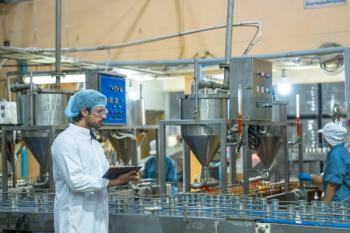
Best of the Week: New Raman Spectrometer Product Line, Best of Spectroscopy Interviews from June 2025
Top articles published this week include a compilation of some of the top KOL interviews for the month of June, an announcement from DialAct Corporation about a new product line of Raman spectrometers, and an inside look at Raman spectroscopy in biomedicine.
This week, Spectroscopy published articles highlighting recent studies in several application areas in analytical spectroscopy, including biomedicine and microbiology, astrochemistry, and pharmaceutical analysis. Key techniques highlighted in these articles include laser-induced breakdown spectroscopy (LIBS), Raman spectroscopy, and ultraviolet-visible (UV-vis) spectroscopy. Happy reading!
DialAct Corporation has launched a new line of FDA-registered Raman spectroscopy systems in partnership with UK-based instrument maker Elodiz. The systems are designed for research, teaching, and industrial use and feature single-, dual-, and triple-laser models, modular configurations, and NIST-traceable calibration. Backed by DialAct's U.S.-based support, the new spectrometers expand Elodiz’s reach in North America (1). This launch comes amid strong market growth, with the global Raman spectroscopy market expected to nearly double from $1.47 billion in 2025 to $2.88 billion by 2034, driven largely by increasing adoption in pharmaceutical and R&D sectors (1).
In a recent review article that was published in the Journal of Photochemistry and Photobiology B: Biology, the research team highlighted the role that Raman spectroscopy is playing in microbiological and biomedical research (2). The authors explain in their paper that Raman spectroscopy, because it is non-invasive, has been used for diagnostics, microbial taxonomy, and molecular biology (2). Enhanced techniques like surface-enhanced Raman spectroscopy (SERS) and tip-enhanced Raman spectroscopy (TERS) enable detection of minute biomolecular changes, aiding early cancer diagnosis, drug analysis, and real-time oxygen monitoring (2). Based on the current trends, the researchers mention in their article that they believe Raman spectroscopy will become vital in personalized medicine and molecular diagnostics (2).
This month, Spectroscopy featured interviews with leading researchers using analytical spectroscopy across diverse fields. Geraldine Richmond, 2025 NYSAS Gold Medal winner, discussed her laser-based research on molecular behavior at liquid interfaces and her advocacy for women in science (3). Richard Russo highlighted uranium analysis using optimized LIBS with picogram-level sensitivity (3). Brett McGuire previewed the astrochemistry mini-symposium at ISMS 2024, spotlighting networking and student opportunities (3). Lucy Semerjian shared findings on metal levels found in pet food being sold in the United Arab Emirates (UAE), urging dietary rotation to reduce health risks (3). And finally, Fran Adar reflected on 40 years of Raman spectroscopy and offered insights for newcomers to the field.
In a recent study, researchers from Georgia College and State University and Purdue University developed and tested a rapid, cost-effective method to detect counterfeit over-the-counter medication syrups using Raman and UV–visible spectroscopy combined with multivariate analysis. Published in Spectrochimica Acta Part A, the technique accurately identifies and quantifies key active ingredients like acetaminophen and guaifenesin without the need for complex sample preparation (4). With high predictive accuracy and detection limits as low as 0.02 mg/mL, this approach is well-suited for field use and in situ testing (4). The method offers a scalable, low-cost solution for manufacturers and regulators to improve quality control and combat counterfeit drugs globally.
In this edition of “Inside the Laboratory,” Brett McGuire of the Massachusetts Institute of Technology (MIT) discusses his research group's focus on astrochemistry, particularly the detection of complex molecules in space. Using custom-built broadband microwave spectrometers, the team conducts rotational spectroscopy to identify molecular signatures, especially in cold interstellar environments (5). Their work emphasizes aromatic and polycyclic aromatic molecules, including collaborations with other labs to study larger structures (5). By analyzing rotational transitions, fitting data through quantum mechanical models, and comparing results with radio telescope observations, McGuire’s team aims to uncover how complex space chemistry can become, while also integrating machine learning to enhance spectral analysis and molecular discovery (5).
References
- Wetzel, W. DialAct Corporation Announces New Raman Spectrometer Product Line in Partnership with Elodiz. Spectroscopy. Available at:
https://www.spectroscopyonline.com/view/dialact-corporation-announces-new-raman-spectrometer-product-line-in-partnership-with-elodiz (accessed 2025-06-25). - Workman, Jr., J. How Raman Spectroscopy Is Transforming Biomedicine and Microbiology. Spectroscopy. Available at:
https://www.spectroscopyonline.com/view/how-raman-spectroscopy-is-transforming-biomedicine-and-microbiology (accessed 2025-06-25). - Wetzel, W. In Conversation: Geraldine Richmond, Richard Russo, and More. Spectroscopy. Available at:
https://www.spectroscopyonline.com/view/in-conversation-geraldine-richmond-richard-russo-and-more (accessed 2025-06-25) - Workman, Jr., J. New Spectroscopy Methods Target Counterfeit Oral Medication Syrups. Spectroscopy. Available at:
https://www.spectroscopyonline.com/view/new-spectroscopy-methods-target-counterfeit-oral-medication-syrups (accessed 2025-06-25). - Wetzel, W. Inside the Laboratory: The McGuire Group at the Massachusetts Institute of Technology. Spectroscopy. Available at:
https://www.spectroscopyonline.com/view/inside-the-laboratory-the-mcguire-group-at-the-massachusetts-institute-of-technology (accessed 2025-06-25).
Newsletter
Get essential updates on the latest spectroscopy technologies, regulatory standards, and best practices—subscribe today to Spectroscopy.





